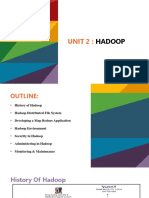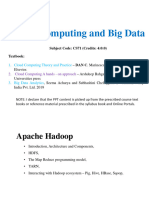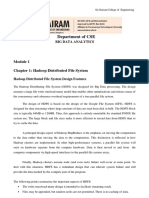0% found this document useful (0 votes)
15 views3 pagesHDFS
Hadoop Distributed File System (HDFS) is a scalable and fault-tolerant storage system designed for managing large datasets across distributed environments. It operates on commodity hardware, utilizing a write-once and read-many access pattern, making it suitable for very large files but not ideal for low latency or small file applications. Key components include the Name Node, which manages metadata, and Data Nodes, which store data blocks, with a Secondary Name Node providing backup to the primary Name Node.
Uploaded by
kostaroopaliCopyright
© © All Rights Reserved
We take content rights seriously. If you suspect this is your content, claim it here.
Available Formats
Download as DOCX, PDF, TXT or read online on Scribd
0% found this document useful (0 votes)
15 views3 pagesHDFS
Hadoop Distributed File System (HDFS) is a scalable and fault-tolerant storage system designed for managing large datasets across distributed environments. It operates on commodity hardware, utilizing a write-once and read-many access pattern, making it suitable for very large files but not ideal for low latency or small file applications. Key components include the Name Node, which manages metadata, and Data Nodes, which store data blocks, with a Secondary Name Node providing backup to the primary Name Node.
Uploaded by
kostaroopaliCopyright
© © All Rights Reserved
We take content rights seriously. If you suspect this is your content, claim it here.
Available Formats
Download as DOCX, PDF, TXT or read online on Scribd
/ 3























































































